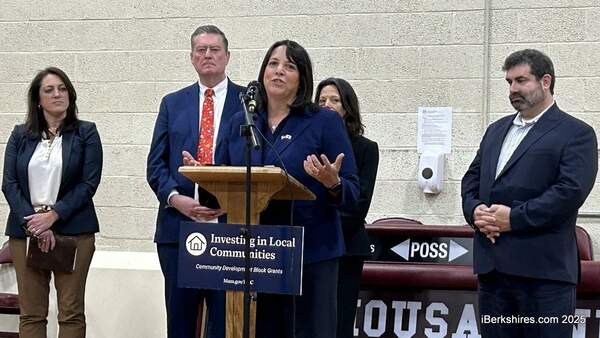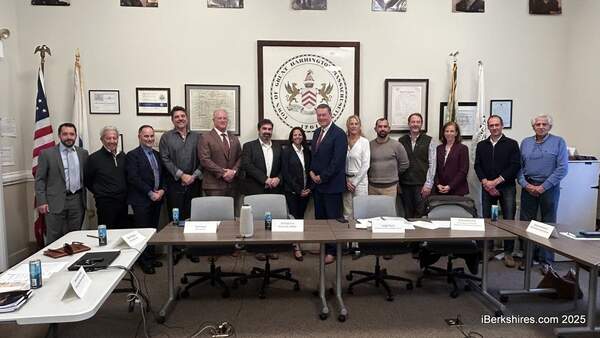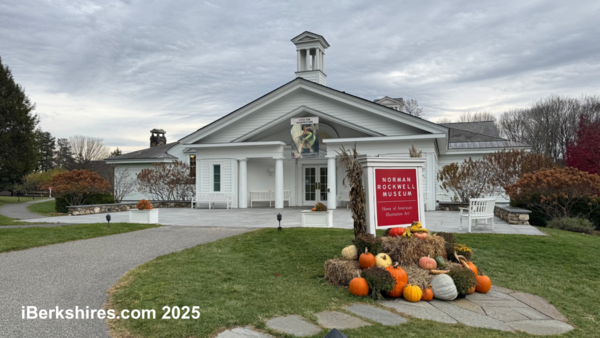
Governor Promises Broadband to All Towns by 2013
 Sandisfield residents gathered to see the governor and show support for the MBI project. |
Gov. Deval Patrick, along with state and local officials, residents and utility industry leaders gathered at the Sandisfield Firehouse on Tuesday morning to kick off construction of the MassBroadband 123 fiber-optic network project.
The governor described it as "an historic effort" to connect the state's citizens, one that began four years ago.
The 1,300-mile Internet network, which is scheduled to be completed by July 2013, will finally bring high-speed Internet to the some 120 communities (many of them in the Berkshires) in Western, north central and southeastern Massachusetts. According to MBI director Judith Dumont, the road to providing "last mile" access for rural communities has been a difficult one.
"I've never had such a simple mission," Dumont said. "Turns out that closing the digital divide isn't that simple.
"The mission of MBI isn't complete. We still have to worry about that last mile connection," she continued. "This is a project that involves private-sector investment and public-sector money. We are celebrating our first year, which I like to call the year of procurements, permits and planning. Now we can move on to infrastructure. I got my first hard hat last week; that has to be a good sign."
Over the next two years, the project, which has garnered more than $80 million in federal grants, will bring broadband to 333,500 households and 44,000 businesses in the area. The project will also provide much-needed revenue and jobs for "last mile" communities.
Tim Scott, vice president of Axia NGNetworks USA (the company that will serve as the network operator for the project), said the benefits of such a large expansion project are endless.
 |
| Broadband Bill Becomes Law Patrick Announces Broadband Highway Partnership Western Mass. Broadband Initiative Gets $72M Boost Broadband Project Gets Final Federal Approval |
"From the Axia perspective the most refreshing thing about this project is the very positive start," he said. "This is a very important initiative for Axia in the U.S. We will be hiring locally, within Massachusetts and investing $35 million to $40 million of our capital into the state. We also have another initiative, the I-91 Fast Start Program, that will be offering early services on the I-91 corridor as early as this fall."
Despite the initiative of Axia and G4S Technology, the design/build partner for the project, the governor put utility leaders, including Peter Bowman, vice president of external affairs for Verizon, and Peter Clarke, president of Western Massachusetts Electric Co., in the hot seat, directing the two to speed up the construction of the "Golden Highway."
"You have a real critical role in getting this up and running," Patrick said to the two men. "If there is going to be a haggling and reconcilement period, you had better get to 'yes' quick. You've got 35,000 poles to cover in the next two years."
Many of those poles and much of the project is located in towns like Sandisfield. Selectman Patrick Barrett said just having Internet access has the potential to change the town itself.
"The governor is placing Sandisfield at the political center of Massachusetts," Barrett said. "This will transform our town. Businesses without high-speed Internet are at a distinct disadvantage. Having broadband technology will be an invaluable device ... and will allow children in Sandisfield to finally compete in a global economy."
While hilltown residents wait and wonder, the governor is confident that the two-year mark will be reached with no problems and only a little pressure.
"I feel like I'm in exactly the right place at the right time," he said. "This is the final stage of an historic effort to bring high-speed Internet into every corner of the commonwealth. One hundred twenty three communities in this state have gone long enough without a modern 'on' ramp. Through construction alone we expect to create hundreds of new jobs and strengthen public institutions.
"I know it has taken a long time to get to this point but at least now we are going somewhere. We'll have better tools to get more done."
Tags: broadband,
















